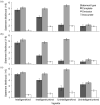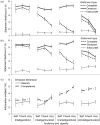Stereotyping by omission: eliminate the negative, accentuate the positive
- PMID: 22448889
- PMCID: PMC4251455
- DOI: 10.1037/a0027717
Stereotyping by omission: eliminate the negative, accentuate the positive
Abstract
Communicators, motivated by strategic self-presentation, selectively underreport negative content in describing their impressions of individuals and stereotypes of groups, particularly for targets whom they view ambivalently with respect to warmth and competence. Communicators avoid overtly inaccurate descriptions, preferring to omit negative information and emphasize positive information about mixed individual targets (Study 1). With more public audiences, communicators increasingly prefer negativity omission to complete accuracy (Study 2), a process driven by self-presentation concerns (Study 3) and moderated by bidimensional ambivalence. Similarly, in an extension of the Princeton Trilogy studies, reported stereotypes of ethnic and national outgroups systematically omitted negative dimensions over 75 years--as anti-prejudice norms intensified--while neutral and positive stereotype dimensions remained constant (Study 4). Multiple assessment methods confirm this stereotyping-by-omission phenomenon (Study 5). Implications of negativity omission for innuendo and stereotype stagnation are discussed.
2012 APA, all rights reserved
Figures





References
-
- Allport GW. The nature of prejudice. Cambridge, MA: Perseus Books; 1954/1979.
-
- Ames DR, Bianchi EC, Magee JC. Professed impressions: What people say about others affects onlookers’ perceptions of speakers’ power and warmth. Journal of Experimental Social Psychology. 2010;46:152–158.
-
- Ames DR, Welch WT. The ecology of everyday first encounters: Prevalent circumstances and the impact of individual differences. 2011. Unpublished manuscript.
-
- Anderson NH. Likableness ratings of 555 personality-trait words. Journal of Personality and Social Psychology. 1968;9:272–279. - PubMed
-
- Armitage CJ. Beyond attitudinal ambivalence: Effects of belief homogeneity on attitude-intention-behaviour relations. European Journal of Social Psychology. 2003;33:551–563.

